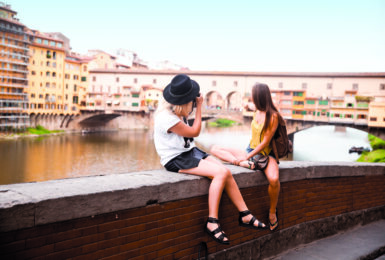Planning a European trip? Be sure not to skip this beautiful Polish city. Kraków is located in the southern part of Poland along the Vistula River. Dating back to the 7th century, it’s one of the oldest cities in Poland and rich with culture and stunning architecture.
Compared to most major European cities such as Paris, Rome and Amsterdam, it’s also one of the most overlooked. The good news? I found that Kraków was an amazing place just waiting to be discovered. If you get the chance to visit, you won’t be left disappointed (or with an empty stomach). Here are just some of the many reasons why…
1. Main Market Square
Kraków boasts Europe’s largest medieval market square, lined with shops and restaurants. The most famous is the Cloth Hall (or ‘Sukiennice’), which is located in the centre. The Cloth Hall was designed in the 1300s and then redesigned (due to a major fire) in the late 1500s. Shopping here is like stepping back in time. When my husband, Matt, and I visited this mall from the past, the first thing we noticed were the numerous crests painted on the walls.
Also, make sure to add St. Mary’s Basilica to your visit list. The interior is all blues and golds, and absolutely breathtaking. Make sure you look up at the ceiling. The church is open to tourists for a small fee, but you’re also invited to pray and attend mass (for free).

Image source:Kaitlyn Chebowski
2. The Kraków bagel
Be on the lookout for street carts selling the infamous Kraków Bagel, or ‘obwarzanek krakowski’ in Polish. The bagels are DELICIOUS, and easily the favorite snack we had in Kraków. Prices range from 1.5 to 2 zloty, so it’s definitely affordable for travellers on a budget.

Image source:Kaitlyn Chebowski
3. Wawel Castle and Cathedral
You can find this thousand-year-old complex just south of the main market square, along the Vistula River. Some say that it’s the Polish version of England’s Buckingham Palace and Westminster Abbey combined. Wawel is located on a small hill, and once you reach the top, you walk into a beautiful courtyard.
We visited in the spring, and there were flowers everywhere. The cathedral is also the burial place of many Polish saints and royalty.
Read More:
5 reasons you must visit Poland on your next European trip

Image source:Kaitlyn Chebowski
4. Wieliczka Salt Mine
While it’s a little way from the city centre, the Wieliczka Salt Mine is a must-see. The mine is over 700 years old, making it the oldest mine in Poland. In my opinion, the most impressive part is the Chapel of St. Kinga. This chapel is made entirely of salt and everything is hand-carved! Despite being 101 meters (331 feet) below the surface, regular Sunday masses and weddings are held here.
Legend has it that the Hungarian princess, Princess Kinga, brought salt to Poland when she married Boleslaw V the Chaste. Later, she became the patron saint of salt miners in and around Krakow.
Salt can be seen everywhere in the mine (no surprise there). On the tours, you’re even encouraged to taste the walls for salt. Try running your hand on the wall then licking your hand.
Read More:
This 1,700-year-old underground city in Poland is a bucket list must

Image source:Kaitlyn Chebowski
5. Auschwitz-Birkenau Memorial and Museum
Auschwitz-Birkenau is about an hour’s drive west from Kraków in Oswiecim, and day tours are offered from the city. I think that everyone should take the time to see the camps, where a million plus lives were taken. It’s a more serious tour excursion but it’s a crucial part of Poland’s history and a must-see to get a full understanding of the atrocities that occurred here in the 20th century.
It’s a sombre reminder of the evil we’re capable of, but also the good. You might be wondering how you can find the good here, but I’m talking about the heroic acts of the victims, such as St. Father Maximilian Kolbe.
Father Kolbe was a Polish priest sent to Auschwitz in 1941. That summer, one prisoner escaped and as punishment, the German Camp Commander chose ten men to die by starvation in an underground bunker. One of the selected men cried out about his wife and children and Father Kolbe volunteered to take his place. It was reported that Kolbe led prisoners in prayer and always remained calm. He was the only prisoner left after two weeks of starvation, when the guards finally injected him with a lethal injection. An eyewitness said that his face remained calm and radiant throughout it all.

Image source:Kaitlyn Chebowski



